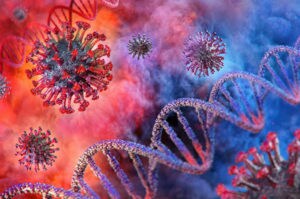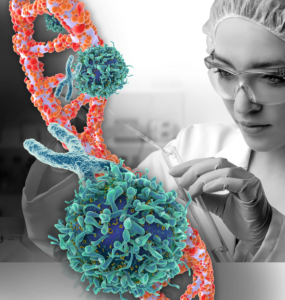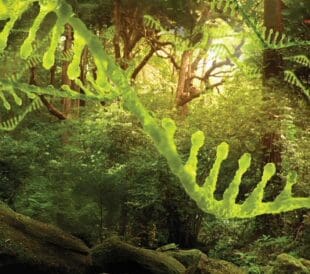Continuing Global Presence and Infections
What Strains of SARS-CoV-2 Are Circulating?
The COVID-19 pandemic continues to cause significant disruptions around the globe. The continuing viral presence and new infections raise the possibility that SARS-CoV-2 will evolve into new variants with slightly different biological characteristics. This has been observed since December 2020, when the first variant of concern (B.1.1.7, recently given the Alpha designation) arose in the UK and rapidly spread. This was followed by independent appearances of the B.1.351 variant (Beta), the P.1 variant (Gamma), the B.1.617.2 variant (Delta), and most recently B.1.1.529 (Omicron).

The Challenge of Monitoring Viral Strains in Populations
Surveillance Allows Tracking, Tracing, and Intervention
Throughout the pandemic, researchers and public health authorities have had to monitor which strain was present and circulating in their populations. Surveilling the circulating strain allowed them to track and trace exposures and intervene if and when appropriate.
Various Methods Exist for Surveillance of SARS-CoV-2 Variants
- The Applied Biosystems™ TaqMan® SARS-CoV-2 Mutation family of genotyping assays allows investigators to select from a menu of specific assays that detect specific nucleic acid changes.
- Next Generation Sequencing (NGS) approaches, such as the Ion AmpliSeq SARS-CoV-2 Insight Research Assay, can provide complete sequence coverage of the viral genome in a sample, facilitating detection of existing or novel mutations.
- Finally, we have developed a panel of wet lab-tested Sanger sequencing primers that enable researchers to focus on specific regions of the genome that might harbor mutations.
These multiple surveillance solutions provide researchers with the ability to identify, detect, and confirm new and emerging SARS-CoV-2 strains.
Related: SARS-CoV-2 Omicron Variant Surveillance
New SARS-CoV-2 Variants of Concern
Researchers & Public Health Need Rapid Virus Strain Identification
Sanger Sequencing Covers Unique & Specific Mutations for Variants of Concern
Because of the newly emerging variants of concern (VOCs), researchers and public health officials need to have a rapid method for determining whether a sample potentially contains one of these VOCs. To help investigators with this, we turned to the previously-described, proven set of Sanger sequencing primers (1). We selected sequencing primers that could cover unique and specific mutations for each of the VOCs. First, mutations were chosen that could detect the strain with greater than 95% sensitivity (2). Second, mutations that were common between the strains were ignored – the mutations unique for the variants were the focus of this selection. One exception was made for the S-gene del69/70del mutation – this mutation is characteristic of both the Alpha and Omicron variants (3, 4). Next, primers covering these mutations were chosen using the SARS-CoV-2 Sanger Primer Pair Lookup App (5). In some cases, a single primer pair covered more than one mutation.
Related: Explore the SARS-CoV-2 Variants and Mutations Interactive Viewer and Get the Poster
| = | Alpha | Beta | Gamma | Delta | Omicron |
| SC2M1-3 | Orf1ab T265I | ||||
| SC2M1-8 | Orf1ab T1001I | ||||
| SC2M1-9 | Orf1ab S1188L | ||||
| SC2M1-13 | Orf1ab K1655N | ||||
| SC2M1-14 | Orf1ab A1708D | Orf1ab K1795Q | |||
| SC2M1-18 | Orf1ab I2230T | ||||
| SC2M1-26 | Orf1ab K3353R | ||||
| SC2M1-27 | Orf1ab P3395H | ||||
| SC2M1-40 | Orf1ab G5063S | ||||
| SC2M1-55 | S del69/70 | S D80A | S L18F, T20N, P26S | S del69/70 | |
| SC2M1-56 | S D215G, del241/243 | S D138Y, R190S | |||
| SC2M1-57 | S G339D | ||||
| SC2M1-58 | S E484K, N501Y | S K471T, E484K, N501Y | S L452R, T478K | S G446S | |
| SC2M1-59 | S D614G | ||||
| SC2M1-60 | S T716I | S A701V | S P681R | S D614G, H665Y, N679K, P681H, | |
| SC2M1-62b | S 982A | S D950N | |||
| SC2M1-63 | S D1118H | S T1027I | |||
| SC2M1-64 | S V1176F | ||||
| SC2M1-65 | Orf3a Q57H | Orf3a S26L | |||
| SC2M1-66 | Orf3a S171L | ORF3a S253P | |||
| SC2M1-67 | E P71L | E T9I | |||
| SC2M1-67b | M I82T | M Q19E, A63T | |||
| SC2M1-70 | Orf7a V82A | ||||
| SC2M1-71 | Orf8 Q27*, R52I, Y73C | Orf8 E92K | |||
| SC2M1-72b | N D3L | N P80R | N D63G | ||
| SC2M1-73 | N R203K, G204R | N T205I | |||
| SC2M1-74 | N D377Y |
Table 1. Primer sets for Sanger sequencing are in the leftmost column; variant of concern strain names are in the topmost row. Mutations unique for the VOC are listed in the boxes as gene name followed by the amino acid change. Yellow boxes highlight mutations that can be picked up with a single sequencing primer pair; red boxes are unique mutations that can be picked up with a unique primer pair.
Sanger Sequencing Selection Results
The results of the selection are shown in Table 1. The white cells/fields/blocks indicate that there are no unique mutations in that strain that will be picked up by the primers. They can still be used for confirming SARS-CoV-2 sequence in that amplicon, but they are not expected to reveal strain-specific information.
Primer Pairs that Cover Unique Mutations for the Variant
The cells/fields/blocks highlighted in yellow denote primer pairs that cover unique mutations for the variant. Note that in some cases, the same primers are listed for different strains. This simply means that the primers will identify different strain-specific mutations that fall into the same amplicon. For example, the primer set SC2M1-67b will identify the M-gene Q19E and M-gene A63T of the Omicron strain, as well as the M-gene I82T of the Delta strain.  The amino acid changes covered by the amplicon are indicated in the box. Some of these primer sets with the most overlap might be most flexible for possible strain identification. For example, the primer set SC2M1-60 will pick up unique mutations in Alpha, Beta, Delta and four in Omicron – but since Gamma has no characteristic mutations in this amplicon, the primer set will not identify Gamma.
The amino acid changes covered by the amplicon are indicated in the box. Some of these primer sets with the most overlap might be most flexible for possible strain identification. For example, the primer set SC2M1-60 will pick up unique mutations in Alpha, Beta, Delta and four in Omicron – but since Gamma has no characteristic mutations in this amplicon, the primer set will not identify Gamma.
Primers that Pick Up a Characteristic Mutation in Only One Strain
The cells/fields/blocks highlighted in red denote the primers that will pick up a characteristic mutation in only one strain. These may be useful if a surveillance strategy involves choosing strain-specific primers that can provide a unique outcome.
Primer Sets for Rapid Front-Line Screening for Presence of VOCs
The table provides information about the primers that can pick up some of the most characteristic mutations in variants of concern. However, a positive result that identifies one of the mutations is not a solid identification of a particular VOC. It merely is suggestive that the VOC is present, and more testing is needed for an unambiguous ID. For an unambiguous identification, all of the mutations that have been defined for the VOC should be determined by reflex testing. Nevertheless, these primer sets may be useful for investigators who need rapid, front-line screening for the possible presence of the common VOCs.
SARS-CoV-2 Surveillance Resources and Solutions
We provide researchers with the ability to identify, detect, and confirm new and emerging SARS-CoV-2 strains.
- SARS-CoV-2 Epidemiological Surveillance
- TaqMan SARS-CoV-2 Mutation Panel
- Ion AmpliSeq SARS-CoV-2 Insight Research Assay
- Sanger Sequencing Solutions for SARS-CoV-2 Research
—
References
- https://www.thermofisher.com/us/en/home/life-science/sequencing/sanger-sequencing/applications/sars-cov-2-research.html
- https://www.gisaid.org/
- Kidd, M., et al., S-Variant SARS-CoV-2 Lineage B1.1.7 Is Associated With Significantly Higher Viral Load in Samples Tested by TaqPath Polymerase Chain Reaction. J Infect Dis, 2021. 223(10): p. 1666-1670.
- https://www.cdc.gov/coronavirus/2019-ncov/science/science-briefs/scientific-brief-omicron-variant.html
- http://gsd-datalake-sars-cov2-sanger-primer-lookup.s3-website-us-east-1.amazonaws.com/




Leave a Reply